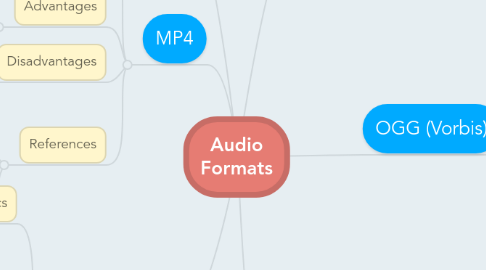
1. MIDI
1.1. Characteristics
1.1.1. It is an extension file that stores sequences from MIDI dispositives called synthesizers.
1.1.2. MIDI files can be modified by special and different programs used for WAV or MP3 formats.
1.1.3. Used by the most important players of the market such as Windows Media Player and QuickTime.
1.2. Advantages
1.2.1. It allows audio with reduced weight.
1.2.2. It does not keep the sound, just the necessary information so it could be reproduced.
1.3. Disadvantages
1.3.1. You should have at least a little musical knowledge.
1.3.2. MIDI formats don't allow you to have richness of sound nuances like the other formats do.
1.4. References
1.4.1. Educación, M. (2008). Formatos de audio. Retrieved January 16, 2017, from http://www.ite.educacion.es/formacion/materiales/107/cd/audio/audio0102.html
1.4.2. Extensión de archivo MIDI. Retrieved January 16, 2017, from http://www.online-convert.com/es/formato-de-archivo/midi
1.5. Example of MIDI format: http://www.mediafire.com/file/cd6a7kvvfwad4xz/The_Neighbourhood-Sweater_Weather.mid
2. MP4
2.1. Characteristics
2.1.1. MP4 file format was Apple's QuickTime file format.
2.1.2. Format designed to store audiovisual data.
2.1.3. The MP4 player is QuickTime.
2.2. Advantages
2.2.1. MPEG-4 allows each streaming over the internet, multiplexing of multiple video and audio streams in one file, variable frame- and bit-rates, subtitles and still images.
2.3. Disadvantages
2.3.1. mp4 is still not as widely used in computer and hardware players as the *.mp3
2.4. References
2.4.1. Development, C. (1998). What is MP4? MP4 audio file format description. Retrieved January 18, 2017, from https://www.coolutils.com/Formats/MP4
2.4.2. Institute, S. (2017). What is MP4? - definition from Techopedia. Retrieved January 18, 2017, from https://www.techopedia.com/definition/10713/mp4
3. WAV
3.1. Characteristics
3.1.1. Short for Waveform Audio Format, normally used on Microsoft Windows.
3.1.2. Stores audio data in blocks.
3.2. Advantages
3.2.1. Very popular and widely used
3.3. Disadvantages
3.3.1. Its usefulness has been declining
3.3.2. There are better lossless audio formats
3.4. References
3.4.1. Harris, M. (2016, September 23). Learn about the WAV file format. Retrieved January 18, 2017, from Lifewire, https://www.lifewire.com/what-is-wav-format-2438583
4. MP3
4.1. Characteristics
4.1.1. Compressed files
4.1.2. Compession level = bit rate
4.1.3. Standard bit rate: 128kbps
4.1.4. Highest bit rate: 320kbps
4.1.5. Two of the most known and used players for this format are iTunes and Windows Media Player.
4.2. Advantages
4.2.1. High quality at low bit rates
4.3. Disadvantage
4.3.1. Most audio CD players won't play MP3's burmed onto a CD.
4.3.2. A separate program is needed to decompress the file into WAV.
4.4. References
4.4.1. Babin, P. (2012, January 23). File Types and Characteristics AUDIO. Retrieved January 15, 2017, from Basic computer operation Tutorial, http://www.bcot1.com/filetypesandcharacteristicsaudiofiles.html
4.4.2. Digital audio file type comparison. (2007, February 27). Retrieved January 16, 2017, from http://www.disca.upv.es/adomenec/IASPA/tema2/delaweb/AudioFiletypes.html
5. OGG (Vorbis)
5.1. Disadvantages
5.1.1. Apple can't support OGG file formats.
5.1.2. It is a format that is not known by many.
5.2. Characteristics
5.2.1. Origin: Foundation Xiph.org
5.2.2. Is an open container format created under unrestricted software patents.
5.2.3. Its ranging is from 16-128 kbps (kilobits per second)
5.2.4. Meaning: it derives from the jargon word “ogging”, that means killing of a carrier by a suicide run in the game Netrek.
5.3. Advantages
5.3.1. Is an open container format created under unrestricted software patents.
5.3.2. OGG containers are capable of encoding audio, video, and other codes within the file.
5.4. References
5.4.1. OGG file extension. Retrieved January 14, 2017, from http://www.online-convert.com/file-format/ogg
5.4.2. de Educación, M. (2008). Formatos de audio. Retrieved January 16, 2017, from http://www.ite.educacion.es/formacion/materiales/107/cd/audio/audio0102.html
